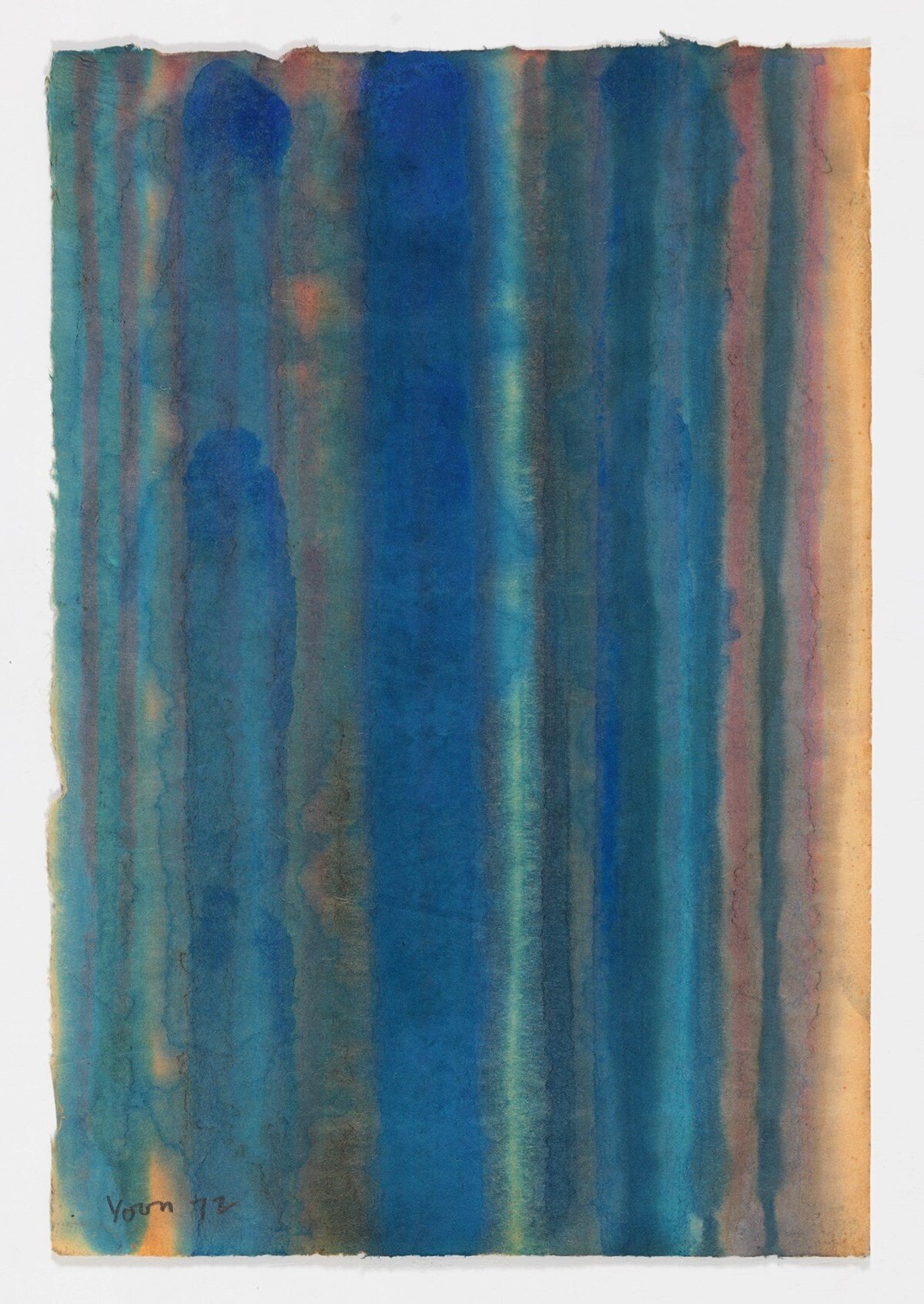Yun Hyong-keun at his atelier in Sinchon, 1974. Courtesy Estate of Yun Hyong-keun. Image Copyright: Yun Seong-ryeol.
Spend some time looking at a painting by artist Yun Hyong-keun (1928 – 2007), and you might imagine that you’re looking at a group of trees. Dark, vertical forms stand at either side of the canvas. Seen one way, they appear to be massive tree trunks on either side of an open clearing. Or seen another way, they could be the dark edges of a wooded area at night, and in between them, the beam of a flashlight splits the darkness. Yun Hyong-keun is a widely acclaimed abstract painter, but there is something unusually earthy about his works on paper and canvas. His compositions seem to echo the architecture of the natural world, not in a sweet or cloying way, but with a sense of nature’s great power. With the knowledge that he spent time as a dissident during the Korean war hiding in a forest, the sight of large, imposing trees is a complex thing to behold. Are they protectors? Do they portend danger? Yun Hyong-keun spent decades of his extraordinary career negotiating these forms two dimensionally, all the while exploring and expanding on traditional Korean painting and paper-making techniques.
Yun Hyong-Keun, Umber-Blue (1978). Oil on cotton. 80.6 cm x 100 cm. Courtesy Estate of Yun Hyong-keun. Image Copyright: Yun Seong-ryeol.
In an essay for Ocula Magazine written on the occasion of Yun’s exhibition at Venice’s Palazzo Fortuny in 2019, critic Sherry Paik recounted the artist’s harrowing youth during the decades of World War II, the Japanese occupation of Korea, and the Korean War. According to the exhibition’s curator, Kim Inhye, he never set out to be a political artist, whose work referenced or mocked propaganda. But the circumstances of his life wouldn’t permit him to be a bystander. During his childhood in the 1930’s in Cheongju, Korea was occupied by Japan, and he was 17 when the end of World War II terminated the occupation in 1945. Yun went to study painting at Seoul National University, but he participated in protests against the U.S. Military Government in Korea, which had established the school, and he was expelled. Because of his activities, Yun was then placed under surveillance and enrolled in an anti-Communist program designed to re-educate suspected communists called the Bodo League. In 1950, when the Korean War began, many members (some of whom didn’t even realize they had been signed up) were executed. Yun escaped arrest and death by hiding in the woods.
Yun Hyong-keun, Burnt Umber & Ultramarine (1989). Oil on linen. 45.5 x 61 cm. Courtesy Estate of Yun Hyong-keun. Image Copyright: Yun Seong-ryeol.
Remarkably, Yun never stopped thinking about art, or making it whenever he could. In the early 1950s, he met the artist Kim Whanki, who helped Yun enroll at Hongik University in Seoul where he continued painting. His work at this time was awash in color, and he used vivid hues to make abstract forms. He painted on hanji—a traditional Korean paper made from the bark of mulberry trees—on which color would bleed and give his abstract shapes soft, feathery edges. By the 1970s, Yun and Kim were both considered members of a movement in abstract Korean contemporary art called Dansaekhwa. Working during these decades in postwar Korea, artists like Yun and his contemporaries did not have access to abundant artists’ materials. They were creative, and used what they had at hand: Korean handmade paper (hanji), pencils and ink, even coal, burlap, and iron. According to Sherry Paik, the Dansaekhwa artists experimented with “ways of manipulating material, including soaking, pulling, pushing, dragging, or ripping paper.”
Yun Hyong-keun, Untitled (1972). Oil on hanji (Korean mulberry paper). 49 x 33 cm. Courtesy Estate of Yun Hyong-keun. Image Copyright: Yun Seong-ryeol.
Yun Hyong-keun: A Retrospective, 2019 Palazzo Fortuny, Venice, Italy. Photo credit: © Laziz Hamani / Courtesy: The Estate of Yun Hyong-keun.
Yun was never entirely at home in Korea for political reasons, but his work started to gain attention abroad in Japan in the mid-1970s. By this time he had begun using more creative materials, particularly burnt umber and ultramarine blue paint on raw linen or canvas.
He had an exhibition in 1976 at the Muramatsu Gallery in Tokyo, and collectors in Japan began to buy his work. In the early 1990s, American Artist Donald Judd visited Korea where he had an exhibition at the Inkong Gallery in Seoul. Judd was taken by Yun’s work, and invited him to visit America, and to show his work at the Chinati Foundation in Marfa, Texas in 1994. Yun was then selected by the government of Korea to represent the country at the 46th Venice Biennale—an achievement that would have been nearly impossible to imagine in Yun’s earlier life.
Yun passed away in 2007, aged 79. The exhibition of his work at the Palazzo Fortuny was a meaningful coda to his exhibition at the Venice Biennale several decades earlier. The space in which the exhibition was staged is a grand, imperfect, sometimes raw space, with a riot of textures and colors, surrounded by water. Yun’s work always reflected nature’s mystery. He used natural materials inventively throughout his life to realize his ideas, from mulberry bark paper and burnt umber to linen and charcoal. Seen against the backdrop of this idiosyncratic, historic setting—rather than workaday perfection of a typical white cube gallery—Yun’s paintings seemed right at home: works of art, perched on the line that divides abstract design from natural forms, made with the materials and tools at hand, mapping the edges of nature, as the water lapped against the building.
Yun Hyong-keun: A Retrospective, 2019, Palazzo Fortuny, Venice, Italy. Photo credit: © Laziz Hamani.






